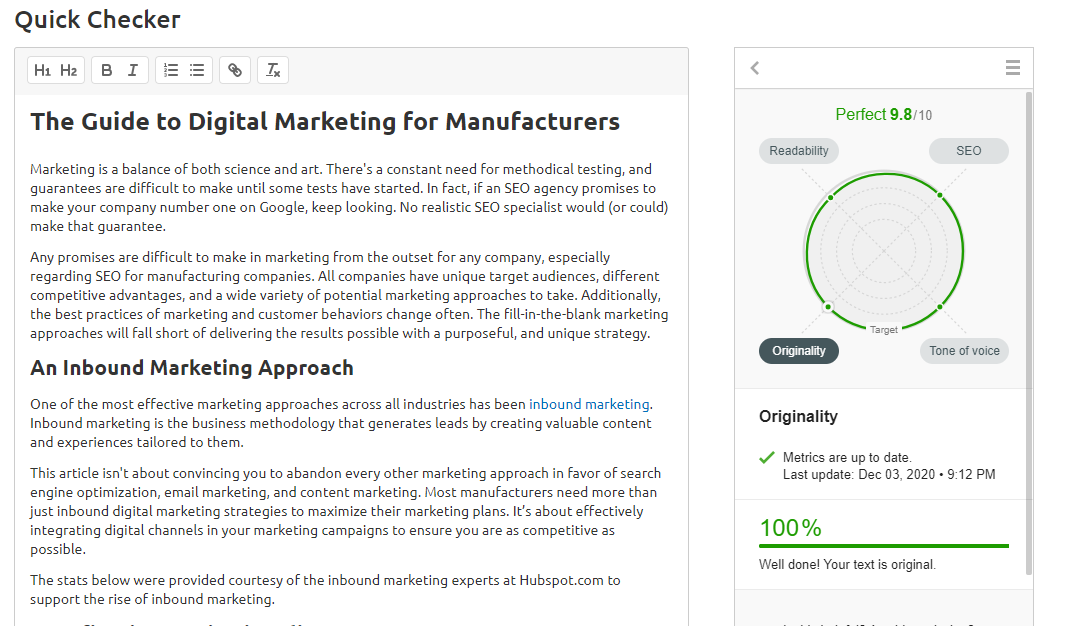Digital marketing is a vital part of all manufacturers' marketing strategies. With all the terms, concepts and platforms out there, marketing can be confusing if you're just starting your digital marketing plan. We created a guide to give you an overview of what you should consider when planning.
- Stats of Digital Marketing & Manufacturers
- Importance of Digital Marketing
- Types of Marketing
- Mobile Optimization
- Blogs
- Social Media
- Digital Marketing Tools
Digital Marketing & Manufacturers
In August 2020, Capterra conducted an online survey with 149 manufacturers. Survey results reported all of the following:
- 68% of respondents moved their business processes online
- 62% of respondents adopted digital marketing since the start of the pandemic in early 2020
- 72% of respondents are using digital channels to promote products online
- 54% of respondents are using a CRM software tool in combination with their digital marketing
- 51% of respondents reported an increase in website traffic since the pandemic began, with 32% reporting that the increase in website traffic came from new regions or countries
The takeaway? Digital marketing for manufacturers became much more competitive since the start of the pandemic.
Importance of Digital Marketing
First impressions are incredibly important and long lasting. In today's technology-driven environment, the first impression customers have of your business is the homepage of your website.
Research shows 78% of customers started researching online before purchasing.
It is so important to engage visitors immediately with a website design that gives a clear message and represents your company and product accurately.
If you have invested in a professionally designed website but it doesn't generate leads for your sales team, consider SEO services designed specifically for manufacturers.
Types of Marketing
There are two main types of marketing, inbound and outbound marketing. In this post, we cover inbound marketing strategies and topics.
Inbound
Inbound marketing is one of the most effective digital marketing approaches across all industries. According to HubSpot, "Inbound marketing is a set of marketing strategies and techniques focused on pulling relevant prospects and customers towards a business and its products." Additionally, with inbound marketing, costs are 62% less per lead than traditional outbound marketing.
Outbound
The other marketing approach is outbound marketing. This is an approach that involves actively reaching out to potential customers through various channels, such as television advertisements, telemarketing, direct mail, and print advertising.
The goal of outbound marketing is to interrupt people and grab their attention, with the hope of getting them to take some form of action. However, this type of marketing is becoming less popular and successful because today’s audience is highly resistant to intrusive or interruptive content.
Mobile Optimization is Key
Fact: 78% of professionals check email on their phone. This email stat shows the importance of making your emails optimized for mobile viewing, and the webpages associated with the links in your email.
In addition to the benefit of creating a better experience for your prospective customers, a mobile-friendly website is a major SEO ranking factor.
Content: Your Prospects & Customers Expect Value
Content is king. Unfortunately, though, many companies struggle to provide valuable content for their prospects in both emails and on their website. Studies show 91% of email users have unsubscribed from a company’s email list they previously opted into.
Quite frankly, most people don’t want to be sold to every single time they open an email from you or visit your website. When people interact with your brand, they expect to see valuable content that makes their lives better or solves a problem for them.
If your company is struggling to win with content marketing, hit the reset button, and begin with establishing a Brand Voice. Once your brand voice is finalized and your entire content marketing team is using it to craft website copy and email, it's time to move onto blogging.
Blogs: Crucial Component of Digital Marketing

With so many consumers researching information online, company blogs have become a crucial component of an effective digital marketing strategy.
HubSpot reports that companies with a blog receive 55% more traffic than those without blogs. In the same report, you'll find the statistic that companies with blogs produce an average of 67% more leads monthly than companies that don't blog.
Why do blogs work?
People use the internet to find solutions to their problems; they research possible solutions and familiarize themselves with the brands that can help them. They don’t simply buy products or services the very first time they find a brand online; they engage with the brand and look for trust signals.
Sharing helpful blog articles allows you to build trust and position your company as the solution to a problem in the mind of your prospective customers.
This is why we’re huge proponents of blogging. Blogging has become a critical online channel proven to consistently deliver results.
Social Media Generates Traffic
According to HubSpot research, 80% of brands say their community building efforts have resulted in increased traffic. Think about it from a customer perspective; when they are scrolling through the social media platform, they are mentally relaxed and are often more open to receiving information.
Catching your prospects when they are open to receiving information is incredibly valuable for every business. It’s for this reason that most marketers now consider a social media strategy crucial to their business.
Digital Marketing Tools
For inbound marketing campaigns, you will want to use a combination of tools to make your campaign efficient and effective.
Automation Tools
Automation tools are important to digital marketing because they help streamline repetitive and time-consuming tasks. Some common automation tools include:
-
Hubspot
-
Marketo
-
Pardot
-
ActiveCampaign
-
Stellation Media
-
Growthoid
-
Act-On
-
Infusionsoft
-
SendPulse
-
Nitreo
Tracking Tools
Tracking tools are important to digital marketing because they allow marketers to measure and analyze the performance of their campaigns so they can tweak as they need. Some common tracking tools include:
-
Google Analytics
-
Mixpanel
-
Heap
-
Kissmetrics
-
Hotjar
-
SERanking
-
Semrush
-
Adwords
-
Ahrefs
-
Clicky
Mistakes to Avoid
Digital marketing is a vast, complex field with many opportunities– but there are also obstacles. Some common mistakes companies make with digital marketing include the following:
- Not having a clear strategy. Without a clear plan, digital marketing efforts can be ineffective and inefficient.
- Ignoring mobile optimization. The World Advertising Research Center predicts that by 2025, 72% of internet users will only use their smartphones to access the internet. Don’t miss out on a huge marketing opportunity by having a site or running a campaign that isn’t optimized for mobile.
- Forgetting to track and analyze results. If you don’t really pay attention to your results, it's difficult to know what is working and what needs improvement.
- Not targeting the right audience. Failing to segment and target your audience properly can result in wasted resources and poor results.
- Neglecting SEO. This will hurt your website's visibility in search results.
Where to Start
If you’re ready to get started with digital marketing for your manufacturing business, download the free guide below to ensure you are implementing an effective inbound marketing strategy. You can also reach out to the Knowmad team to speak with a marketing expert and request a proposal. We would be happy to help you generate more leads with inbound marketing and SEO services.

William McKee
As a managing partner of Knowmad, William creates sustainable growth for the agency by leading its future vision, driving new revenue, and empowering team member productivity and well-being.








